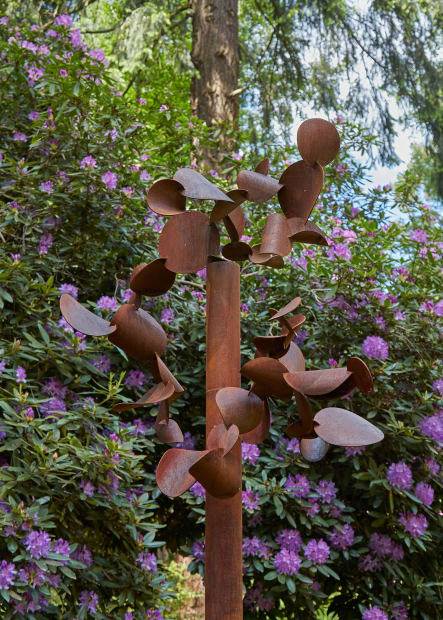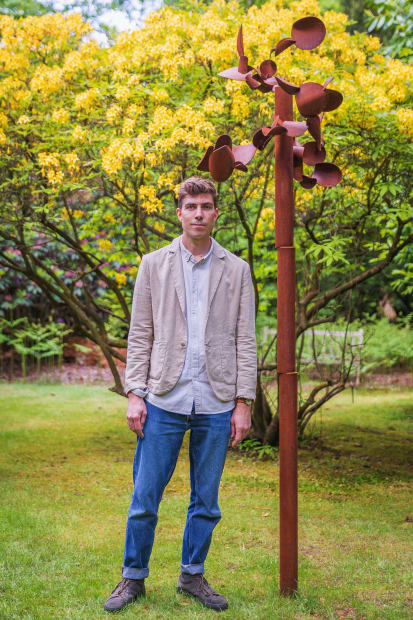-
In Focus: David Murphy
-

-
Three sapling-like 'trees' emerge from the grass under the dappled light of the clearing. Borne of a deep appreciation of nature as a dynamic whole, the sculptures aspire to modulation and movement. Fabricated from gently rolled and folded sheets of weathering steel these sculptures lightly tremble in the passing breeze, animating their branches and sharing with the viewer a responsiveness to their environment.
The untreated surface evolves over time from a rich golden red to a deep chestnut brown, developing an oxidised patina that becomes more subtly beautiful as the years pass by. The use of weathering steel celebrates elemental and temporal change - the entropy of all things.
As with Ikebana, the Japanese art of flower arranging, it is not only the sprays themselves but the space between them is considered part of the formal work, here these spaces create context for the complex geometry of the folded leaves, shading and filtering the light and elegantly connecting ground with sky. -
We spoke with David Murphy to discuss his multifaceted practice, from drawing and painting through to sculpture. We discuss how these mediums feed into one another and how his understanding of sculpture in the landscape has developed since exhibiting in our 1st Edition in 2017.
Your practice moves fluidly between sculpture and drawing/painting. Do you feel that one feeds into the other or are they separate disciplines in your mind?
For me they are essential to one another, they each show the other the way forward. There are occasional phases where I obsess over one kind of work, but I would say in general that I try and keep a few different things happening simultaneously. On the same day, this might involve working between public projects and studio work, between welding and painting, or even simply between two or more paintings. I find it creatively rewarding to be able to move between modes of work - it transfers a certain energy or tension between them. I think my best work lives in this threshold between boundaries, between 2D and 3D, between figuration and abstraction, between the organic and the man-made, in the space just beyond our perception. -

-
You seem to have a painter's eye for material surface in your sculptures, favouring softer, natural patinations over crisp synthetic finishes. Previous works have used exposed brass allowed to gently weather, the High Shade series uses weathering (Corten) steel and most recently these new bronzes take a step further with a beautiful cloudy blue/black patina. At what stage of development does surface finish become a consideration? Does the finish dictate the fabrication material or vice versa?
I would say that an awareness of surface finish is there almost from concept, but of course, different materials have their respective strengths and limitations in terms of fabrication, and so are more or less suited to a certain way of working. The brass for example doesn’t weld at all well, so that material lent itself to a bolted construction... Then there are perfectly good materials that I just don’t like very much - stainless steel and aluminium which feel too coolly inert and unresponsive…it’s very subjective. To my eye, bronze, weathering steel and brass all get better, they develop in the elements and with passing time, and they wear the sum of that experience on their surfaces.
Bronze holds such a place in the canon of sculpture that I think it’s actually quite a difficult material to confront. With the smaller Cut Shade works I wanted to find a way to use bronze where its innate characteristics can be seen a bit differently - as something light and flexible, as the antithesis of heavy metal sculptures… The softness of the bronze sheet means it’s very tactile; it can be folded, rolled and spun by hand using very simple equipment. I also liked that these sculptures are constructed/assembled rather than traditionally cast, and that the patination with all these different oxides brings a really painterly and spontaneous quality to it too. I feel like I found ways to bring it into my own vocabulary and way of working.
-
-
We have spoken privately about the new bronze Cut Shade series having an almost "design object” seductiveness, and I know recent series’ have seen you venture into stained glass and architectural reliefs. Is product and industrial design an influence on your practice at all?
I’m really curious about this, and I wonder what it is about them that does that?! Is it a scale thing? a sense of familiarity? a slickness? Normally we think of Design in terms of functionality, or as an embodied solution to a problem, but I think all the meanings are getting quite slippery, and that’s exciting. In a sense finished artworks are a sort of solution to their own sets of problems, and I would definitely say that my sculptures are ‘designed’, whether that is through material use and processing, in the details of how elements come together, or in how the materials will perform in their setting…I don’t think all these things are beyond the responsibility of the artist. I have a broad interest in Design and Architecture, and I feel there is a lot of innovation in and between both fields that can be extremely inspiring to artists. It can’t help but feed in on some level. I’m now working on larger projects as part of bigger teams, and that brings new challenges around how to steer the concept through to completion without making too many compromises. But it has also taught me a great deal too - the architectural timescale unfolds over years not weeks, and it brings a different kind of rigour to the creative process…it necessitates a different kind of patience.
This is your second time exhibiting at Contemporary Sculpture Fulmer, with the benefit of experience did you approach this new work differently at all? And by extension, are there different considerations when working in a landscape as opposed to some of the public urban commissions you have recently completed?
Yes, it’s good to be back showing at Fulmer again, I think it’s been 5 years?! I’m seeking two main things with the outdoor works, whether they be temporary or permanent, urban or otherwise…firstly some feeling of resonance between artwork and situation, and secondly some capacity for change or transformation. Even though they’re not permanent, the High Shade works were developed with a more or less specific location in mind. They are quite subtle, modest works, but the setting in that little colourful glade is perfect. Though they are tree-like, to me they imply a youthfulness, as if they are still growing… I liked the idea of ‘shading’ as a connecting concept between the location in this protective enclave, and for the work itself - the complex geometry of the folded leaves that filters the light and elegantly connects the notions of ground and sky.
-






